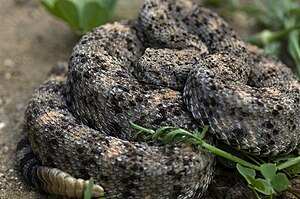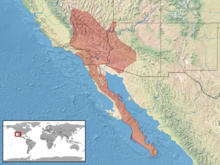Spotted rattlesnake
| Spotted rattlesnake | ||||||||||||
|---|---|---|---|---|---|---|---|---|---|---|---|---|

Spotted rattlesnake ( Crotalus mitchellii ) |
||||||||||||
| Systematics | ||||||||||||
|
||||||||||||
| Scientific name | ||||||||||||
| Crotalus mitchellii | ||||||||||||
| ( Cope , 1861) |
The spotted rattlesnake ( Crotalus mitchellii ) is a species of rattlesnake ( Crotalus ) found in southern California and Nevada as well as all of Baja California ( Mexico ) and some islands in the Gulf of California .
features
The spotted rattlesnake is a relatively large rattlesnake with an average body length of about one meter. The representatives of the subspecies C. m. angelensis a little longer with an average length of 1.30 meters, the representatives of the C. m. muertensis is slightly smaller than the other individuals with an average of 0.70 meters.
The species varies a lot in its body color. The typical basic color is light gray to yellowish gray; there are also individuals with a cream, yellow, orange-yellow, pink or light brown basic color. The pattern consists of spots in the front part of the body, which gradually merge into transverse bars towards the tail and are mostly dark gray; However, these too are very different in color and can take on the entire color spectrum of the basic colors. In addition, they are often only indistinctly recognizable and barely noticeable in some individuals.
distribution and habitat
The distribution area of the spotted rattlesnake ranges from southern California , southern Nevada and western Arizona to Baja California ( Mexico ), which is almost completely populated. In addition, some islands in the Gulf of California and the Pacific islands Magdalena and Santa Margarita are inhabited by her.
The snake's habitat is dominated by stony desert areas with cacti and other succulents as the predominant vegetation.
Snake venom
The venom of the spotted rattlesnake varies greatly in its effects and in the amount of poison; As a rule, it mainly leads to local tissue damage and pain, which is followed by general nausea .
Systematics
There are currently five subspecies of the spotted rattlesnake:
- C. m. angelensis endemic to Angel de la Guarda Island in the Gulf of California
- C. m. mitchellii in the southern half of Baja California
- C. m. muertensis endemic to El Muerto Island in the Gulf of California
- C. m. pyrrhus in the northern half of Baja California, southern California, and western Arizona
- C. m. stephensi in southern Nevada and parts of southern California.
C. m. stephensi was distinguished from the other subspecies in 2007 on the basis of molecular biological data as a separate species called panamint rattlesnake ( C. stephensi ).
supporting documents
Evidence cited
- ↑ Michael E. Douglas, Marlis R. Douglas, Gordon W. Schuett, Louis W. Porras, Blake L. Thomason: Genealogical Concordance between Mitochondrial and Nuclear DNAs Supports Species Recognition of the Panamint Rattlesnake ( Crotalus mitchellii stephensi ). Copeia 2007 (4); Pp. 920-932. Full text PDF ( page no longer available , search in web archives ) Info: The link was automatically marked as defective. Please check the link according to the instructions and then remove this notice.
literature
- Chris Mattison: Rattlers! - A natural history of rattlesnakes. Blandford, London 1996; P. 115; ISBN 0-7137-2534-6
Web links
- Crotalus mitchellii in The Reptile Database
- Crotalus mitchellii inthe IUCN 2013 Red List of Threatened Species . Posted by: Frost, DR, Hammerson, GA & Gadsden, H., 2007. Retrieved October 5, 2013.

